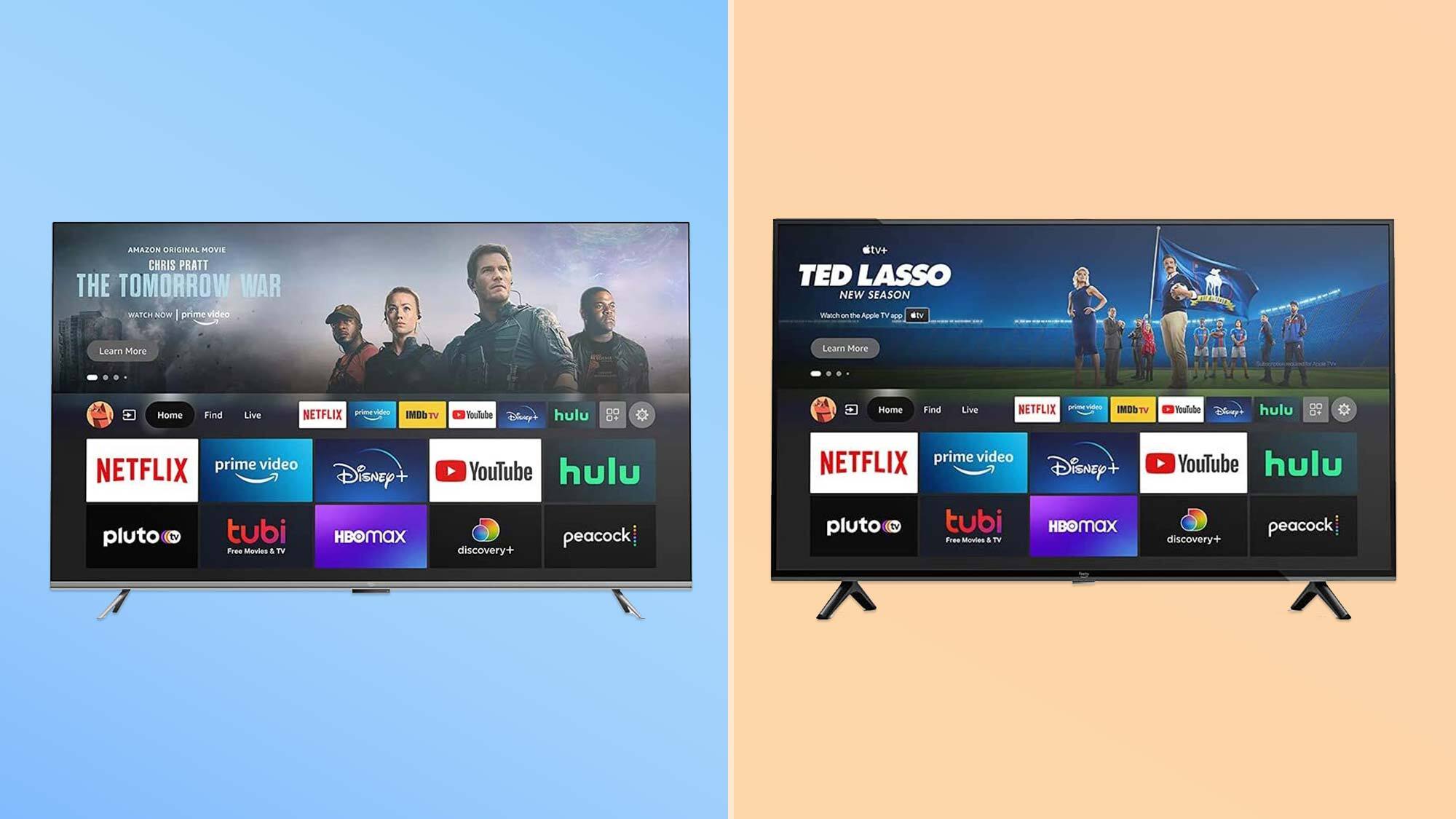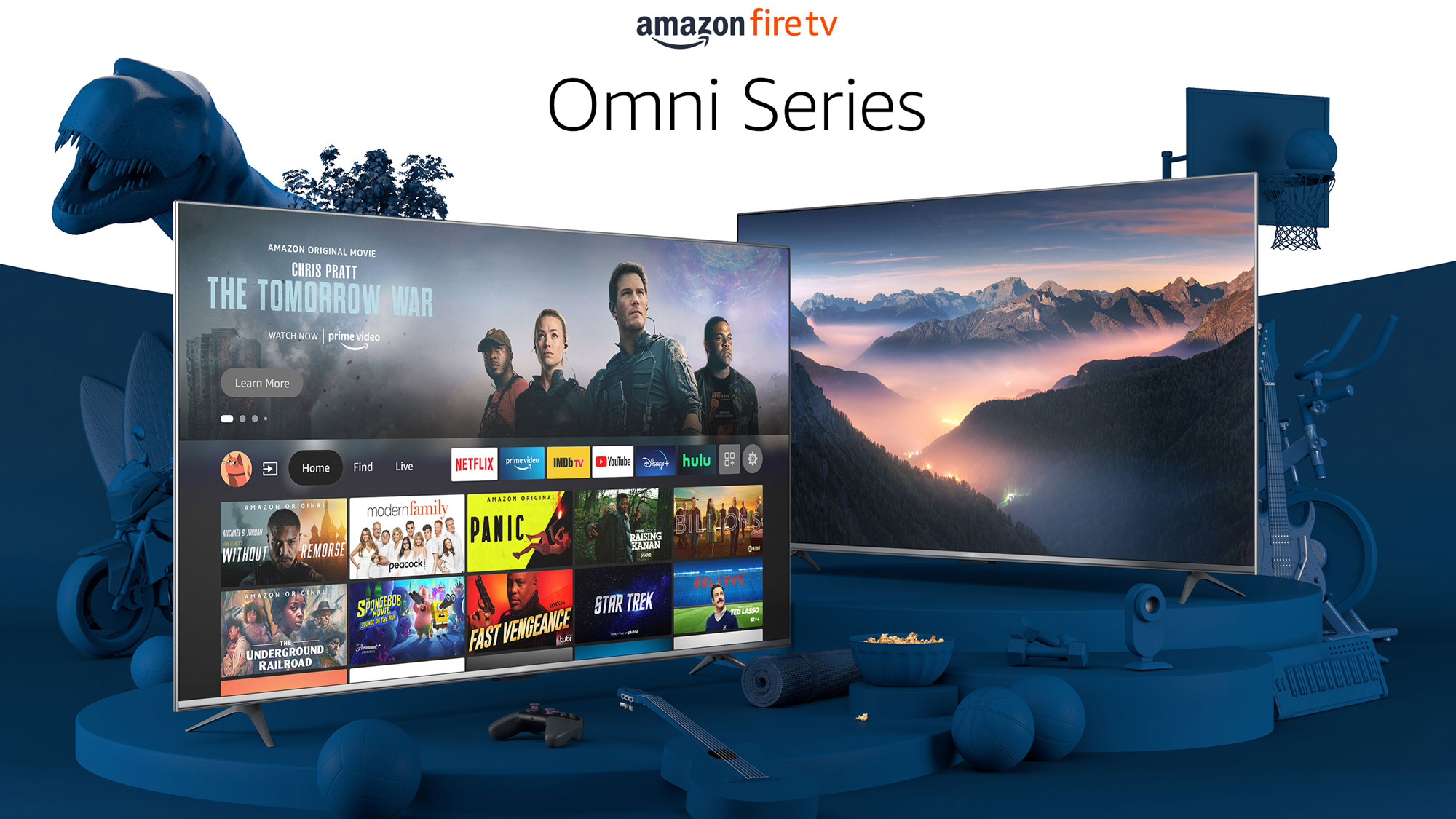Amazon Fire TV Omni Series vs Fire TV 4-Series: What’s the difference?
The first Amazon-made TVs have arrived – here's what the new Omni and Fire TV 4-Series models offer

Update: Amazon's Fire TV lineup is on sale for Prime Day. Check out our Prime Day TV deals live blog for all the savings.
The age of Amazon-made Fire TVs is here, and it looks like the mega-retailer is finally making Fire-powered smart TVs into something more than just a loss-leader for sales events. But what's the difference between the Omni and 4-Series? And which is the better Fire TV to buy?
Amazon has a big batch of new Fire TV models coming out this fall, with the new flagship Fire TV Omni series and the more basic Fire TV 4-Series. After years of cheap TVs using Amazon Fire TV to power the cheapest of cheap smart TVs, these are mid-range and even premium models that deliver smarter functions, improved performance features and more sophisticated designs.
So what's the difference? The quick answer is that the Fire TV Omni series is the top-of-the-line for Fire TVs. It comes with more features, smarter capabilities and better designs. But there's a lot more to it than that, and the more basic Fire TV 4-Series shouldn't be written off as more of the same cheap Amazon TVs.
Here's what's different between the Fire TV Omni Series and the Fire TV 4-Series.
Fire TV Omni series vs 4-Series: Specs
| Header Cell - Column 0 | Fire TV 4-Series | Fire TV Omni Series |
|---|---|---|
| Price range | $369 - $519 | $409 - $1,099 |
| Display sizes | 43", 50", 55" | 43", 50", 55", 65", 75" |
| HDR format | HDR 10, HLG | HDR 10, HLG, Dolby Vision (65 and 75-inch models only) |
| Backlight type | Direct LED | Direct LED |
| Refresh rate | 60 Hz | 60 Hz |
| HDMI ports | 3 HDMI 2.0 + 1 HDMI 2.1 with eARC | 3 HDMI 2.0 + 1 HDMI 2.1 with eARC |
| Ethernet | 1 Ethernet port | 1 Ethernet port |
| USB | 1 USB port | 1 USB port |
| Remote | Alexa Voice Remote | Alexa Voice Remote |
| Voice support | Fire TV Alexa Voice Remote or the Fire TV app | Hands-free with Alexa |
| Audio support | Dolby Digital Plus with passthrough of Dolby-encoded audio | Dolby Digital Plus with passthrough of Dolby-encoded audio |
| Audio power | 8W + 8W | 8W + 8W |
| OS | Fire TV OS | Fire TV OS |
| Finish Color | Black (45", 50", 55") | Black (43", 50", 55"), Metallic silver (65", 75") |
Fire TV Omni series vs 4-Series: Fire TV
Before we jump into specific comparisons of the different model lines, let's quickly get acquainted with Amazon's Fire TV, a smart TV platform began life purely on streaming sticks, and has grown into a family of smart products, from some of the best streaming devices to some of the most hotly anticipated smart TVs you can get.
Fire TV started as a derivative of Google's Android operating system, much like the forked version of Android used on Amazon's Fire tablets. Built on the foundation of Android, the Fire TV operating system is made for big screens, and designed around unique inputs, like TV remote controls and voice commands via Amazon Alexa.
It also serves as a showcase for Amazon's robust streaming options, with Amazon Prime Video taking center stage on the home screen and in content recommendations. IMDBtv (another Amazon property) also gets promoted in the Fire TV system, along with ads for physical products on Amazon.
If that sounds like a lot of Amazon stuff being pushed on Fire TVs, you're not wrong. The aggressive advertising and Amazon-centric nature of the platform has been our biggest complaint with Fire-powered smart TVs for years, and it doesn't look like that's due to change anytime soon.
However, Fire TVs are shaping up to be decent players in the smart TV space. With a recently redesigned home page, support for some of the most popular non-Amazon streaming services, and a handful of new smart features that tie together the smart TV with Amazon's Ring and Echo smart home devices, the platform is maturing, and the latest TV announcements have us thinking that Amazon's Fire TVs might finally be turning into something better.
And that's great news for both the Fire TV 4-Series and the Omni series, since both model lines have the same Fire TV experience at their core. They offer the same software, the same app selection, use the same style of remote control, and will be offered side by side through both Amazon and Best buy in the coming weeks.
Fire TV Omni series vs 4-Series: Size and price

Amazon declares the Fire TV 4-Series to be best for "everyday entertainment," but what they really mean is available in smaller sizes, and at lower prices. Selling in 43, 50 and 55 inch sizes, there's a distinct lack of big screen options in the basic 4-Series lineup.
Starting at $369 for the smallest 43-inch model and ranging up to $519 for the 55-inch set, the Amazon Fire TV 4-Series isn't quite as inexpensive as we saw in our Toshiba C350 Fire TV review or the Insignia F30 Series Fire TV review, but there's every reason to believe that these prices will drop in the near future. With Black Friday and Cyber Monday sales looming in November, I'd expect the newest Amazon Fire TV 4-Series sets to be steeply discounted before the year ends.

The more expensive Omni series is also available in 43, 50 and 55-inch sizes, but with a slightly higher price. What is notably more expensive are the Omni's larger 65 and 75-inch models, which are a natural fit for TV shoppers that want bigger and better options. Amazon claims that the Omni series is better for "a cinematic home theater experience", and screen size is surely the main justification for this claim.
That $270 price jump from the 55-inch model to the 65-inch is significant, but Amazon also adds some additional features to the larger models, including a stylish metallic finish and better HDR support. But the $1,099 price for the 75-inch model may be a little harder to swallow, since that puts it at a higher price than many competitors.
It's a clear move to reposition Amazon Fire TVs as mid-range and even premium TVs, but without some more substantial features to justify that price, it may not be the hot seller that more affordable models are.
Fire TV Omni Series vs 4-Series: Design
While we haven't had a close look at the physical designs of either Amazon-made Fire TV, there are a few details that are worth noting.
First, the Fire TV 4-Series looks to have the same sort of basic, black plastic construction that we've seen on past models from third-party manufacturers like insignia and Toshiba. The Omni models, on the other hand, are available with either a black or silvery finish, and features metal trim on the chassis and bezel.
Comparing images of what's included with each TV, the Fire TV 4-Series has basic black plastic feet, while the more premium omni series appears to use metal feet. The overall layout may look the same, but the use of different materials will definitely give a more premium build quality to the Omni series products.
The other important thing worth noting is that, despite some differences in construction, many design details are identical between the two model lines. Both the budget-friendly Fire TV 4-Series and the more expensive Omni series use the same Alexa-enabled TV remote, and have the same port selection, with a very similar looking rear chassis and layout.
Fire TV 4 Omni series vs 4-Series: HDR

Both the Amazon Fire 4-Series and the more premium Omni series offer HDR support, but there are some differences.
On smaller screens, the two model lines are the same, offering basic HDR support for HDR10 and HLG, but not Dolby Vision.
But HDR is also limited in its effectiveness through the use of direct backlight without local dimming. With no discrete dimming zones, the backlight cannot adjust to produce the brighter brights and deeper darks that make the most of HDR content.
The Omni series also features Dolby Vision support, offering the best premium HDR format on the 65 and 75-inch models. However, without local dimming, the impact of this format support will be minimal.
Fire TV Omni series vs 4-Series: Alexa
One of the key features of Amazon Fire TVs is the built-in Alexa voice assistant, which gives you all of the same functions as an Amazon Echo smart speaker, along with voice search for TV shows and movies and voice control for functions like volume and opening apps.
The new Fire TVs also get some additional TV features, like the ability to use Netflix's Play Something recommendation feature with the phrase “Alexa, Play Something on Netflix”. You can even get TikTok videos, which can also be auto-played with the phrase “Alexa, play TikTok.”

The Fire TV 4-Series delivers almost everything that the more premium Omni models do, but that Alexa support is limited to voice input through the remote control, or through a paired Echo smart speaker. The TV itself does not have far-field microphones to listen to the entire room. (While that may sound like a step down from the hands-free Alexa options on the Omni series, the privacy minded TV shoppers out there may actually consider this an improvement.)
Amazon is also taking pains to offer a more premium experience with the built-in Amazon Alexa. While all Fire TVs have Amazon Alexa built-in, the Omni series features hands-free interaction thanks to an array of four far-field microphones that listen to the room just like an Amazon Echo smart speaker. That means no talking into the remote, and no pressing a button to get Alexa to listen.

Privacy wonks should take heart at one additional feature, however, because the Omni series TVs are also equipped with a physical switch to turn those microphones off. That means ensuring the privacy of your private conversations is as simple as flipping a switch, without having to dig through obscure settings menus or worry that your privacy is undermined through software bugs or malicious hackers.
Fire TV Omni series vs 4-Series: Smart features
Since both the Fire TV 4-Series and Omni series are Amazon Fire TVs, it's understandable that the two will overlap considerably in their smart feature offerings. Both have Alexa voice interaction built in, for voice control, content search and smart home interaction. Both sets will have the same Fire TV home screen and navigation experience, and both sets will draw from the same pool of thousands of apps, including popular streaming services like Netflix, Disney Plus, HBO Max, Hulu, Peacock and YouTube's many apps.
But the Omni is also touted as having a few additional smart features. One is picture-in-picture support for watching video feeds from devices like a Ring doorbell camera, letting you view the feed from the camera without interrupting your show.
Similarly, if you have multiple camera feeds, such as from an array of Ring security cameras around your house and property, you can have all of those feeds on a dedicated row on the home screen.
Finally, the Omni series promises one major upgrade over the standard Fire TV 4-Series, with support for USB webcam and Zoom calling. Paired with Alexa voice calling, the Omni series will let you initiate Zoom calls with voice control, making it easy to talk to friends and family from the comfort of your couch and larger TV screen.
Fire TV Omni Series vs 4-Series: Which is better for you?
The great news with Amazon's newest Fire TVs is that both model lines appear to be winners. The Fire TV 4-Series sets will continue to be a great option for value focus shoppers, offering solid smart capabilities and decent 4K performance for anyone that simply wants unaffordable 4K smart TV.
The Omni series, with its advanced features and larger screen sizes will offer shoppers a great opportunity to step up to a better overall TV while still getting that same Alexa infused Fire TV smart experience. In terms of pure quality and capability, the Omni series looks to be the winner, delivering a bigger, better picture with better construction and more features.
But the real news here is that as Amazon takes more control over the design and construction of Fire TVs, both model lines appear to have plenty to offer.
Sign up to get the BEST of Tom's Guide direct to your inbox.
Get instant access to breaking news, the hottest reviews, great deals and helpful tips.
Brian Westover is currently Lead Analyst, PCs and Hardware at PCMag. Until recently, however, he was Senior Editor at Tom's Guide, where he led the site's TV coverage for several years, reviewing scores of sets and writing about everything from 8K to HDR to HDMI 2.1. He also put his computing knowledge to good use by reviewing many PCs and Mac devices, and also led our router and home networking coverage. Prior to joining Tom's Guide, he wrote for TopTenReviews and PCMag.

